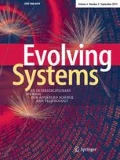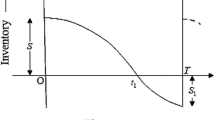Abstract
This article presents a production inventory model for three level production rates with characterizing the preservation technology for deteriorating items to reduce the deterioration rate. The deterioration of the product is considered as probabilistic to make the research a more realistic one. In this paper, a production inventory model with deteriorative items in which three different rates of productions are considered. Two models are considered; the production inventory model without shortages is studied first and with shortages is investigated next. In this paper, shortages are allowed to occur and demand during the stock out period is completely backlogged. Few propositions have been developed and the necessary and sufficient conditions of the existence and uniqueness of the global optimal solutions are suggested. A suitable mathematical model is developed, and the optimal production lot size, which minimizes the total average cost, is derived. The global optimal solution is derived, and an illustrative example is provided and numerically verified. Sensitivity analysis of the optimal solution with respect to the key parameters of the model has been carried out and the implications are discussed. The analysis of the model shows that the solution of the model is quite stable and can be applied for optimizing the total inventory cost of deteriorating items inventory for the business enterprises.

















Similar content being viewed by others
References
Annadurai K, Uthayakumar R (2015) Decaying inventory model with stock-dependent demand and shortages under two-level trade credit. Int J Adv Manuf Technol 77(1):525–543
Cardenas-Barron LE, Sana SS (2014) A production–inventory model for a two-echelon supply chain when demand is dependent on sales teams’ initiatives. Int J Prod Econ 155:249–258
Cardenas-Barron LE, Sarkar B, Trevino-Garza G (2013) Easy and improved algorithms to joint determination of the replenishment lot size and number of shipments for an EPQ model with rework. Math Comput Appl 18:3138–3151
Cardenas-Barron LE, Chung KJ, Trevino-Garza G (2014) Celebrating a century of the economic order quantity model in honor of Ford Whitman Harris. Int J Prod Econ 155:1–7
Covert RP, Philip GC (1973) An EOQ model for items with Weibull distribution deterioration. AIIE Trans 5(4):323–326
Dye CY (2013) The effect of preservation technology investment on a non-instantaneous deteriorating inventory model. Omega 41(5):872–880
Dye CY, Hsieh TP (2012) An optimal replenishment policy for deteriorating items with effective investment in preservation technology. Eur J Oper Res 218(1):106–112
Ghare PM, Schrader GF (1963) A model for exponentially decaying inventory. J Ind Eng 14:238–243
Ghosh SK, Khanra S, Chaudhuri KS (2011) Optimal price and lot size determination for a perishable product under conditions of finite production, partial backordering and lost sale. Appl Math Comput 217(13):6047–6053
Guchhait P, Maiti MK, Maiti M (2013) Production–inventory models for a damageable item with variable demands and inventory costs in an imperfect production process. Int J Prod Econ 144(1):180–188
Hsieh TP, Dye CY (2013) A production inventory model incorporating the effect of preservation technology investment when demand is fluctuating with time. J Comput Appl Math 239:25–36
Hsu PH, Wee M, Teng HM (2010) Preservation technology investment for deteriorating inventory. Int J Prod Econ 124(2):388–394
Johnny CH, Adriano OS, Chang YL (2007) An evaluation of lot-sizing heuristics for deteriorating inventory in material requirements planning systems. Comput Oper Res 34(9):2562–2575
Karuppuchamy A, Uthayakumar R (2015) Decaying inventory model with stock-dependent demand and shortages under two-level trade credit. Int J Adv Manuf Technol 77(1):525–543
Krishnamoorthi C (2012) An economic production lot size model for product life cycle (maturity stage) with defective items with shortages. Opsearch 49(3):253–270
Liao JJ (2007) On an EPQ model for deteriorating items under permissible delay in payments. Appl Math Model 31(3):393–403
Mishra U (2015a) An EOQ model with time dependent Weibull deterioration, quadratic demand and partial backlogging. Int J Appl Comput Math. doi:10.1007/s40819-015-0077-z
Mishra U (2015b) An inventory model for deteriorating items under trapezoidal type demand and controllable deterioration rate. Prod Eng Res Devel 9(3):351–365
Mishra VK, Singh LS (2011) Deteriorating inventory model for time dependent demand and holding cost with partial backlogging. Int J Manage Sci Eng Manage 6(4):267–271
Misra RB (1975) Optimum production lot size model for a system with deteriorating inventory. Int J Prod Res 13(5):495–505
Mondal B, Bhunia AK, Maiti M (2009) Inventory models for defective items incorporating marketing decisions with variable production cost. Appl Math Model 33(6):2845–2852
Mousavi SM, Hajipour V, Niaki STA, Aalikar N (2014) A multiproduct multi-period inventory control problem under inflation and discount: a parameter-tuned particle swarm optimization algorithm. Int J Adv Manuf Technol 70(9–12):1739–1756
Ouyang LY, Wu KS, Yang CT (2006) A study on an inventory model for non-instantaneous deteriorating items with permissible delay in payments. Comput Ind Eng 51(4):637–651
Palanivel M, Uthayakumar R (2013) An EPQ model for deteriorating items with variable production cost, time dependent holding cost and partial backlogging under inflation. Opsearch 52(1):1–17
Palanivel M, Uthayakumar R (2014a) An EPQ model with variable production, probabilistic deterioration and partial backlogging under inflation. J Manag Anal 1(3):200–223
Palanivel M, Uthayakumar R (2014b) A production–inventory model with variable production cost and probabilistic deterioration. Asia Pacific J Math 1(2):197–212
Palanivel M, Uthayakumar R (2015) A production–inventory model with promotional effort, variable production cost and probabilistic deterioration. Int J Syst Assur Eng Manag. doi:10.1007/s13198-015-0345-7
Palanivel M, Priyan S, Uthayakumar R (2015) An inventory model with finite replenishment, probabilistic deterioration and permissible delay in payments. J Manag Anal 2(3):254–279
Sana SS (2013) Sales team’s initiatives and stock sensitive demand-A production control policy. Econ Model 31:783–788
Sarkar B (2012) An EOQ model with delay-in-payments and time-varying deterioration rate. Math Comput Model 55:367–377
Sarkar B (2013) A production–inventory model with probabilistic deterioration in two-echelon supply chain management. Appl Math Model 37(5):138–3151
Sarkar B, Moon I (2011) An EPQ model with inflation in an imperfect production system. Appl Math Comput 217(13):6159–6167
Sarkar M, Sarkar B (2013) An economic manufacturing quantity model with probabilistic deterioration in a production system. Econ Model 31:245–252
Sarkar B, Sana SS, Chaudhuri KS (2010) Optimal reliability, production lot size and safety stock: an economic manufacturing quantity model. Int J Manag Sci Eng Manag 5(3):192–202
Sarkar B, Sana SS, Chaudhuri KS (2013) Inventory model with finite replenishment rate, trade credit policy and price-discount offer. J Ind Eng 2013. doi:10.1155/2013/672504
Sarkar B, Saren S, Wee HM (2013b) An inventory model with variable demand, component cost and selling price for deteriorating items. Econ Model 30:306–310
Sarkar B, Cardenas-Barron LE, Sarkar M, Singghi ML (2014a) An EPQ inventory model with random defective rate, rework process and backorders for a single stage production system. J Manuf Syst 33(3):423–435
Sarkar B, Gupta H, Chaudhuri KS, Goyal SK (2014b) An integrated inventory model with variable lead time, defective units and delay in payments. Appl Math Comput 237:650–658
Sarkar B, Saren S, Cardenas-Barron LE (2015a) An inventory model with trade-credit policy and variable deterioration for fixed lifetime products. Ann Oper Res 229(1):677–702
Sarkar B, Saren S, Cardenas-Barron LE (2015b) An inventory model with trade-credit policy and variable deterioration for fixed lifetime products. Ann Oper Res 229(1):677–702
Sarkar B, Sett BK, Goswami A, Sarkar S (2015c) Mitigation of high-tech products with probabilistic deterioration and inflations. Am J Ind Bus Manag 5(3):73–89
Sett BK, Sarkar B, Goswami A (2012) A two-warehouse inventory model with increasing demand and time varying deterioration. Scientia Iranica Trans E Ind Eng 19:306–310
Shafieezadeh M, Sadegheih A (2014) Developing an integrated inventory management model for multi-item multi-echelon supply chain. Int J Adv Manuf Technol 72(5–8):1099–1119
Sivashankari CK, Panayappan S (2015) Production inventory model for two-level production with deteriorative items and shortages. Int J Adv Manuf Technol 76(9):2003–2014
Uthayakumar R, Rameswari M (2012) Economic order quantity for deteriorating items with time discounting. Int J Adv Manuf Technol 58(5):817–840
Wee HM, Wang WT, Cardenas-Barron LE (2013) An alternative analysis and solution procedure for the EPQ model with rework process at a single-stage manufacturing system with planned backorders. Comput Ind Eng 64(2):748–755
Widyadana GA, Cardenas-Barron LE, Wee HM (2011) Economic order quantity model for deteriorating items and planned backorder level. Math Comput Model 54(5–6):1569–1575
Yang PC, Wee HM (2006) A collaborative inventory system with permissible delay in payment for deteriorating items. Math Comput Model 43(3–4):209–221
Zhang J, Zhenyu B, Wansheng T (2014) Optimal pricing policy for deteriorating items with preservation technology investment. J Ind Manag Optim 10(4):1261–1277
Acknowledgments
Authors wish to express their gratitude to the editors and reviewers for their constructive suggestions and corrections to enhance the clarity of the present paper.
Author information
Authors and Affiliations
Corresponding author
Rights and permissions
About this article
Cite this article
Mishra, U. An inventory model for controllable probabilistic deterioration rate under shortages. Evolving Systems 7, 287–307 (2016). https://doi.org/10.1007/s12530-016-9150-z
Received:
Accepted:
Published:
Issue Date:
DOI: https://doi.org/10.1007/s12530-016-9150-z




